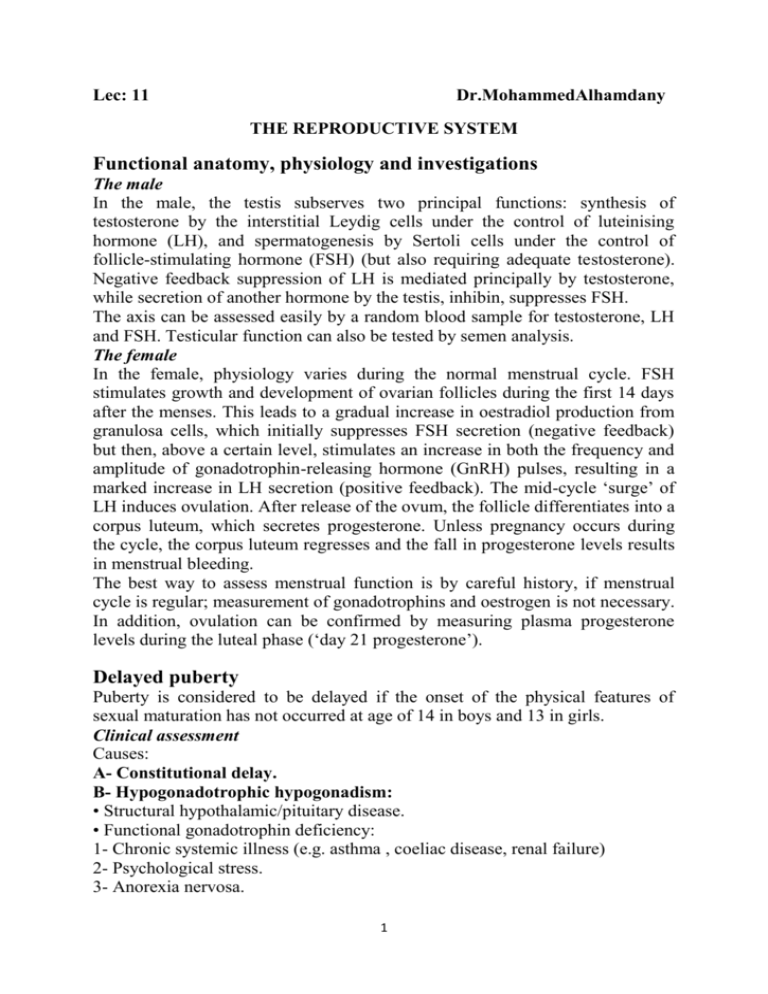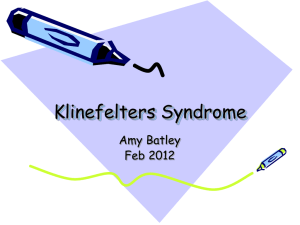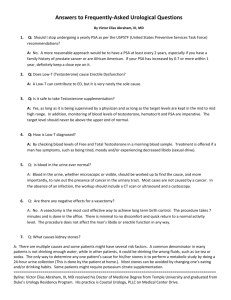pubdoc_12_27126_1660
advertisement

Lec: 11 Dr.MohammedAlhamdany THE REPRODUCTIVE SYSTEM Functional anatomy, physiology and investigations The male In the male, the testis subserves two principal functions: synthesis of testosterone by the interstitial Leydig cells under the control of luteinising hormone (LH), and spermatogenesis by Sertoli cells under the control of follicle-stimulating hormone (FSH) (but also requiring adequate testosterone). Negative feedback suppression of LH is mediated principally by testosterone, while secretion of another hormone by the testis, inhibin, suppresses FSH. The axis can be assessed easily by a random blood sample for testosterone, LH and FSH. Testicular function can also be tested by semen analysis. The female In the female, physiology varies during the normal menstrual cycle. FSH stimulates growth and development of ovarian follicles during the first 14 days after the menses. This leads to a gradual increase in oestradiol production from granulosa cells, which initially suppresses FSH secretion (negative feedback) but then, above a certain level, stimulates an increase in both the frequency and amplitude of gonadotrophin-releasing hormone (GnRH) pulses, resulting in a marked increase in LH secretion (positive feedback). The mid-cycle ‘surge’ of LH induces ovulation. After release of the ovum, the follicle differentiates into a corpus luteum, which secretes progesterone. Unless pregnancy occurs during the cycle, the corpus luteum regresses and the fall in progesterone levels results in menstrual bleeding. The best way to assess menstrual function is by careful history, if menstrual cycle is regular; measurement of gonadotrophins and oestrogen is not necessary. In addition, ovulation can be confirmed by measuring plasma progesterone levels during the luteal phase (‘day 21 progesterone’). Delayed puberty Puberty is considered to be delayed if the onset of the physical features of sexual maturation has not occurred at age of 14 in boys and 13 in girls. Clinical assessment Causes: A- Constitutional delay. B- Hypogonadotrophic hypogonadism: • Structural hypothalamic/pituitary disease. • Functional gonadotrophin deficiency: 1- Chronic systemic illness (e.g. asthma , coeliac disease, renal failure) 2- Psychological stress. 3- Anorexia nervosa. 1 4- Excessive physical exercise. 5- Hyperprolactinaemia. 6- Other endocrine disease (e.g. Cushing’s syndrome, primary hypothyroidism). • Isolated gonadotrophin deficiency (Kallmann’s syndrome). Hypergonadotrophic hypogonadism • Acquired gonadal damage 1- Chemotherapy/radiotherapy to gonads. 2- Trauma/surgery to gonads. 3- Autoimmune gonadal failure. 4- Mumps orchitis. 5- Tuberculosis. 6- Haemochromatosis. • Congenital gonadal disorders: such as Klinefelter’s syndrome (47XXY, male phenotype). Turner’s syndrome (45XO, female phenotype). The key issue is to determine whether the delay in puberty is simply because the ‘clock is running slow’ (constitutional delay of puberty) or because there is pathology in the hypothalamus/pituitary (hypogonadotrophic hypogonadism) or the gonads (hypergonadotrophic hypogonadism). Investigations Key measurements are LH and FSH, testosterone (in boys) and oestradiol (in girls). Chromosome analysis should be performed if gonadotrophin concentrations are elevated. If gonadotrophin concentrations are low, then the differential diagnosis lies between constitutional delay and hypogonadotrophic hypogonadism. A plain X-ray of the wrist and hand may be compared with a set of standard films to obtain a bone age. Full blood count, renal function, liver function, thyroid function and coeliac disease autoantibodies should be measured. If hypogonadotrophic hypogonadism is suspected, neuroimaging and further investigations are required. Management Puberty can be induced using low doses of oral oestrogen in girls, or testosterone in boys. Where possible, the underlying cause should be treated. Amenorrhoea Primary amenorrhoea describes the condition of a female patient who has never menstruated; this usually occurs as a manifestation of delayed puberty but may also be a consequence of anatomical defects of the female reproductive system. Secondary amenorrhoea describes the cessation of menstruation. In nonpregnant women, secondary amenorrhoea is almost invariably a consequence of either ovarian or hypothalamic/pituitary dysfunction. Premature ovarian failure 2 (premature menopause) is defined as ovarian pause occurring before 40 years of age. Causes: 1- Physiological • Pregnancy • Menopause 2- Hypogonadotrophic hypogonadism. 3- Ovarian dysfunction • Hypergonadotrophic hypogonadism. • Polycystic ovarian syndrome. • Androgen-secreting tumours. 4- Uterine dysfunction • Asherman’s syndrome. Investigations Pregnancy should be excluded in women of reproductive age by measuring urine or serum human chorionic gonadotrophin (hCG). Serum LH, FSH, oestradiol, prolactin, testosterone, T4 and TSH should be measured and, in the absence of a menstrual cycle, can be taken at any time. Management Where possible, the underlying cause should be treated. In oestrogen-deficient women, replacement therapy may be necessary to treat symptoms and/or to prevent osteoporosis. Women should be treated with combined oestrogen/progestogen therapy, since unopposed oestrogen increases the risk of endometrial cancer. Cyclical hormone replacement therapy (HRT) regimens typically involve giving oestrogen on days 1–21 and progestogen on days 14–21 of the cycle and this can be conveniently administered as the oral contraceptive pill. Male hypogonadism The clinical features of both hypo- and hypergonadotrophic hypogonadism include loss of libido, lethargy with muscle weakness, and decreased frequency of shaving. Patients may also present with gynaecomastia, infertility, delayed puberty, osteoporosis or anaemia of chronic disease. The causes: is the same of delay puberty. Investigations Male hypogonadism is confirmed by demonstrating a low serum testosterone level. The distinction between hypo- and hypergonadotrophic hypogonadism is by measurement of random LH and FSH. Patients with hypogonadotrophic hypogonadism should be investigated as described for pituitary disease. Biochemical hypogonadism is associated with central obesity and the metabolic syndrome. Patients with hypergonadotrophic hypogonadism should have the testes examined for cryptorchidism or atrophy, and a karyotype performed (to identify Klinefelter’s syndrome). 3 Management Testosterone replacement is clearly indicated in younger men with significant hypogonadism to prevent osteoporosis and to restore muscle power and libido. Routes of testosterone administration are: 1- Intramuscular: A- Testosterone enantate: Every 3–4 wks. It Produces high peaks of testosterone levels and may be symptomatic B- Testosterone undecanoate: Every 3 months with smoother profile than testosterone enantate. 2- Subcutaneous: Testosterone pellets: Every 4–6 months with smoother profile than testosterone enantate but implantation causes scarring and infection. 3- Transdermal: A- Testosterone patch: daily dose, with stable testosterone levels but high incidence of skin hypersensitivity B- Testosterone gel: daily dose with stable testosterone levels; transfer of gel can occur following skin-to-skin contact with another person. 4- Oral: Testosterone undecanoate: Twice daily dose but causing very variable testosterone levels; and risk of hepatotoxicity. First-pass hepatic metabolism of testosterone is highly efficient, so bioavailability of ingested preparations is poor. Testosterone therapy can aggravate prostatic carcinoma; prostate-specific antigen (PSA) should be measured before commencing testosterone therapy in men older than 50 years and monitored annually thereafter. Haemoglobin concentration should also be monitored in older men, as androgen replacement can cause polycythaemia. Testosterone replacement inhibits spermatogenesis. Infertility Infertility affects around 1 in 7 couples of reproductive age, often causing psychological distress. The main causes: Female factor (35–40%) A- Ovulatory dysfunction: 1- Polycystic ovarian syndrome. 2- Hypogonadotrophic hypogonadism. 3- Hypergonadotrophic hypogonadism. B- Tubular dysfunction: 1- Pelvic inflammatory disease (chlamydia, gonorrhoea). 2- Endometriosis. 3- Previous pelvic or abdominal surgery. C- Cervical and/or uterine dysfunction 1- Congenital abnormalities. 4 2- Fibroids. 3- Asherman’s syndrome. Male factor (35–40%) A- Reduced sperm quality or production: 1- Y chromosome microdeletions. 2- Varicocoele. 3- Hypergonadotrophic hypogonadism. 4- Hypogonadotrophic hypogonadism. B- Tubular dysfunction 1- Varicocoele 2- Congenital abnormality. 3- Previous sexually transmitted infection (chlamydia, gonorrhoea). Unexplained or mixed factor (20–35%). Investigations Investigations should generally be performed after a couple has failed to conceive despite unprotected intercourse for 12 months, unless there is an obvious abnormality like amenorrhoea. Both partners need to be investigated. The male partner needs a semen analysis to assess sperm count and quality. In women with regular periods, ovulation can be confirmed by an elevated serum progesterone concentration on day 21 of the menstrual cycle. Transvaginal ultrasound can be used to assess uterine and ovarian anatomy. Tubal patency may be examined at laparoscopy or by hysterosalpingography (HSG; a radio-opaque medium is injected into the uterus and should normally outline the fallopian tubes). Management In women with anovulatory cycles secondary to PCOS , clomifene, which has partial antiestrogen action, blocks negative feedback of oestrogen on the hypothalamus/pituitary, causing gonadotrophin secretion and thus ovulation. In women with gonadotrophin deficiency or in whom anti-oestrogen therapy is unsuccessful, ovulation may be induced by direct stimulation of the ovary by daily injection of FSH and an injection of hCG to induce follicular rupture at the appropriate time. In hypothalamic disease, pulsatile GnRH therapy with a portable infusion pump can be used to stimulate pituitary gonadotrophin secretion (note that nonpulsatile administration of GnRH or its analogues paradoxically suppresses LH and FSH secretion). During gonadotrophin therapy, closer monitoring of follicular growth by transvaginal ultrasonography and blood oestradiol levels is mandatory. ‘Ovarian hyperstimulation syndrome’ is characterised by grossly enlarged ovaries and capillary leak with circulatory shock, pleural effusions and ascites. 5 Anovulatory women who fail to respond to ovulation induction or who have primary ovarian failure may wish to consider using donated eggs or embryos. Surgery to restore fallopian tube patency can be effective but in vitro fertilisation (IVF) is normally recommended. IVF is widely used for many causes of infertility and in unexplained cases of prolonged (> 3 years) infertility. The success of IVF depends on age, with low success rates in women over 40 years. Men with hypogonadotrophic hypogonadism who wish fertility are usually given injections of hCG several times a week (recombinant FSH may also be required in men with hypogonadism of pre-pubertal origin); it may take up to 2 years to achieve satisfactory sperm counts. Surgery is rarely an option in primary testicular disease but removal of a varicocoele can improve semen quality. Extraction of sperm from the epididymis for IVF, and intracytoplasmic sperm injection (ICSI, when single spermatozoa are injected into each oöcyte) are being used increasingly in men with oligospermia or poor sperm quality who have primary testicular disease. Gynaecomastia Gynaecomastia is the presence of glandular breast tissue in males. Normal breast development in women is oestrogen-dependent, while androgens oppose this effect. Gynaecomastia results from an imbalance between androgen and oestrogen activity, which may reflect androgen deficiency or oestrogen excess. Causes: 1- Idiopathic 2- Physiological: neonate, puberty, and elderly. 3- Drug-induced • Cimetidine • Digoxin • Anti-androgens (cyproterone acetate, spironolactone) 4- Hypogonadism. 5- Oestrogen excess • Liver failure (impaired steroid metabolism) • Oestrogen-secreting tumour (for example, of testis) • hCG-secreting tumour (for example, of testis or lung) Investigations If a clinical distinction between gynaecomastia and adipose tissue cannot be made, then ultrasonography or mammography is required. A random blood sample should be taken for testosterone, LH, FSH, oestradiol, prolactin and hCG. Management Gynaecomastia may cause significant psychological distress, especially in adolescent boys, and surgical excision may be justified for cosmetic reasons. 6 Androgen replacement will usually improve gynaecomastia in hypogonadal males and any other identifiable underlying cause. The anti-oestrogen tamoxifen may also be effective in reducing the size of the breast tissue. Polycystic ovarian syndrome Polycystic ovarian syndrome (PCOS) affects up to 10% of women of reproductive age. Features of polycystic ovarian syndrome 1- Pituitary dysfunction: cause high serum LH, and high serum prolactin. 2- Anovulatory menstrual cycles: cause a- Oligomenorrhoea b- Secondary amenorrhoea c- Cystic ovaries d- Infertility 3- Androgen excess: cause Hirsutism and Acne 4- Obesity: cause Hyperglycaemia and Elevated oestrogens 5- Insulin resistance cause Dyslipidaemia and Hypertension The diagnosis of PCOS requires the presence of two of the following three features: 1- menstrual irregularity. 2- clinical or biochemical androgen excess. 3- multiple cysts in the ovaries (most readily detected by transvaginal ultrasound). Management All PCOS patients who are overweight should be encouraged to lose weight, as this can improve several symptoms, including menstrual irregularity, and reduces the risk of type 2 diabetes. Menstrual irregularity and infertility Most women with PCOS have oligomenorrhoea, with irregular, heavy menstrual periods. This may not require treatment unless fertility is desired. Metformin is used by reducing insulin resistance, and may restore regular ovulatory cycles in overweight women, although it is less effective than clomifene at restoring fertility as measured by successful pregnancy. Thiazolidinediones also enhance insulin sensitivity and restore menstrual regularity in PCOS, but are contraindicated in women planning pregnancy. In women who have very few periods each year or are amenorrhoeic, the high oestrogen concentrations associated with PCOS can cause endometrial hyperplasia. Progestogens can be administered on a cyclical basis to induce regular shedding of the endometrium and a withdrawal bleed. 7








